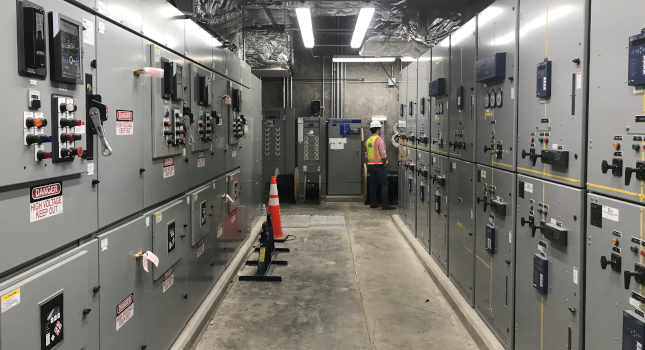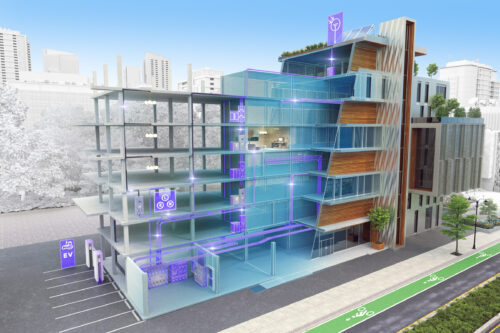Case study: Water supply system gets a much-needed electrical upgrade
An 80-year-old water system was updated with a new medium-voltage electrical system
The Rocky Gorge Pump Station (RGPS) is a raw water pump station located in Laurel, Maryland, that is owned and operated by the Washington Suburban Sanitary Commission (WSSC). The pump station provides raw water to Patuxent Water Filtration Plant and is a key element of WSSC’s potable water supply system for Prince George’s and Montgomery Counties. Originally built in the mid-1940s, CDM Smith provided engineering services, including design and construction, to upgrade its total flow capacity from 72 to 110 million gallons per day.
As part of the upgrade, the existing medium-voltage (MV) electrical system was evaluated and it was determined that a new distribution system would be required. The electrical distribution system included a 33 kilovolt (kV)-4,160 Volt (V) liquid-filled outdoor substation; 4,160 V metal-clad double-ended indoor switchgear; MV motor control centers (MCCs); and MV pumps with variable frequency drives and reduced voltage solid-state soft starters.
Several factors were considered when deciding on using MV. One of the main drivers for this project was the quantity and size of the pump motors used in the pump station, which ranged from 200 horsepower (hp) to 1,500 hp. The total estimated maximum operating loads was approximately 8,000 kilovolt amperes, which is outside the practical capacity for a low-voltage (LV) system due to the high short-circuit current available at this capacity and the potential of dangerous arc flash hazards.

Figure 3: Rocky Gorge Pump Station electrical room layout. Courtesy: Washington Suburban Sanitary Commission
Additionally, MV motor starting equipment is more practical and available when motors exceeding 700-800 hp. Physical space limitations of the existing site and reducing quantity and sizes of conduits and copper wires throughout the pump station were also deciding factors to use MV over LV.
To build a robust electrical distribution system, the design incorporated various protection techniques, such as differential protection of the substation transformers and motors, transformer oil temperature and pressure monitoring, switchgear overcurrent, over voltage, differential and other protective measures. Motor protection management relays were used in addition to regular overcurrent, control and permissive interlocks. To harden the reliability and resiliency of the electrical system, redundant transformers, double-ended switchgear and MCCs and direct current voltage control battery system were used.
As this project was an upgrade to an existing pump station, space constraints of the existing structure and location required continual coordination and consultation with electrical equipment manufacturers and collaborations with architectural, structural and building mechanical engineers during the design. Complying with NFPA 70: National Electrical Code working space requirements, maintaining front and rear access of the switchgear and MCCs for future maintenance and allocating sufficient space to move the equipment in and out of the electrical room were challenges that required extra attention and coordination to overcome.
The engineering work didn’t end at the design stage, as numerous meetings and continual collaborations with approved manufacturers and the construction contractor were required to optimize the equipment layout and arrangements. As the owner and end user of the pump station, WSSC provided continuous input and feedback that were critical to produce a safe, resilient and maintenance-friendly electrical system. Various workshops and on-site meetings were held with the equipment suppliers, owner’s staff, construction contractors and engineering teams to resolve conflicts and ensure the supplied equipment would be operable and can be effectively serviced throughout its expected useful life.

Figure 4: Rocky Gorge Pump Station medium-voltage pumps and motors layout. Courtesy: Washington Suburban Sanitary Commission
The project also involved keeping the pump station functional while the construction was in progress, also known as maintenance of plant operation. This required coordination with the construction contractor to developing a sequence of construction that would minimize facility shutdown while replacing the existing electrical system.
After construction was completed, the upgrade included acceptance testing of all the electrical equipment in accordance with InterNational Electrical Testing Association acceptance testing specifications (known as NETA ATS) and manufacturer standards. The electrical distribution system was also tested using a nondestructive very low frequency testing method.
Lastly, a power system study was completed that included short circuit, protective device coordination and arc flash studies. The protective relay settings that were determined as a part of the study were incorporated in the field and arc flash labels were installed in accordance with NFPA 70E: Standard for Electrical Safety in the Workplace.
Do you have experience and expertise with the topics mentioned in this content? You should consider contributing to our CFE Media editorial team and getting the recognition you and your company deserve. Click here to start this process.






